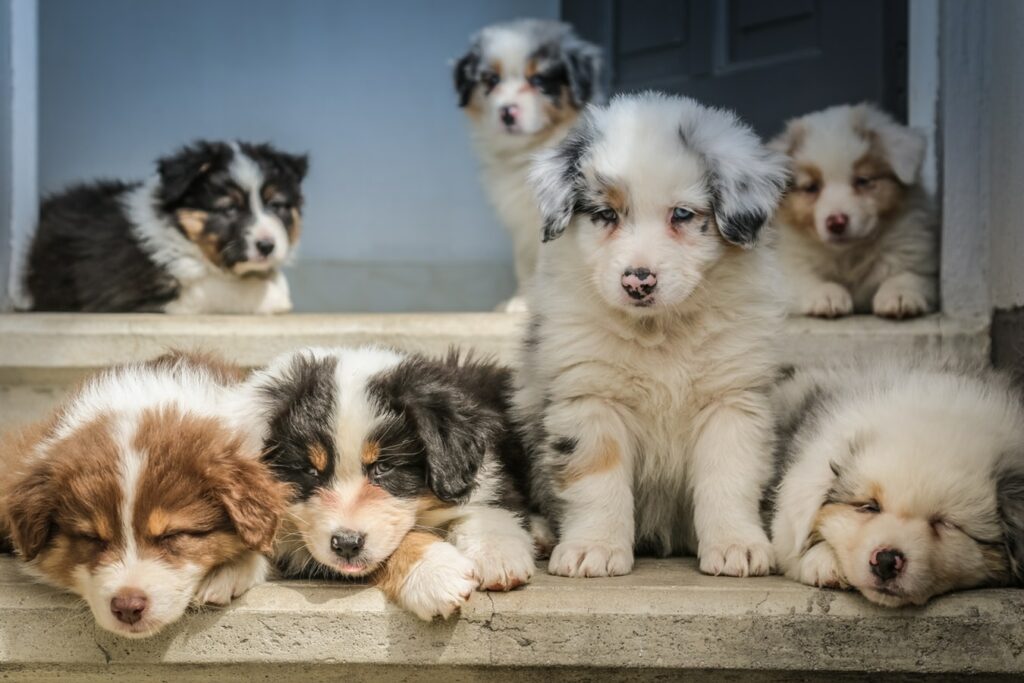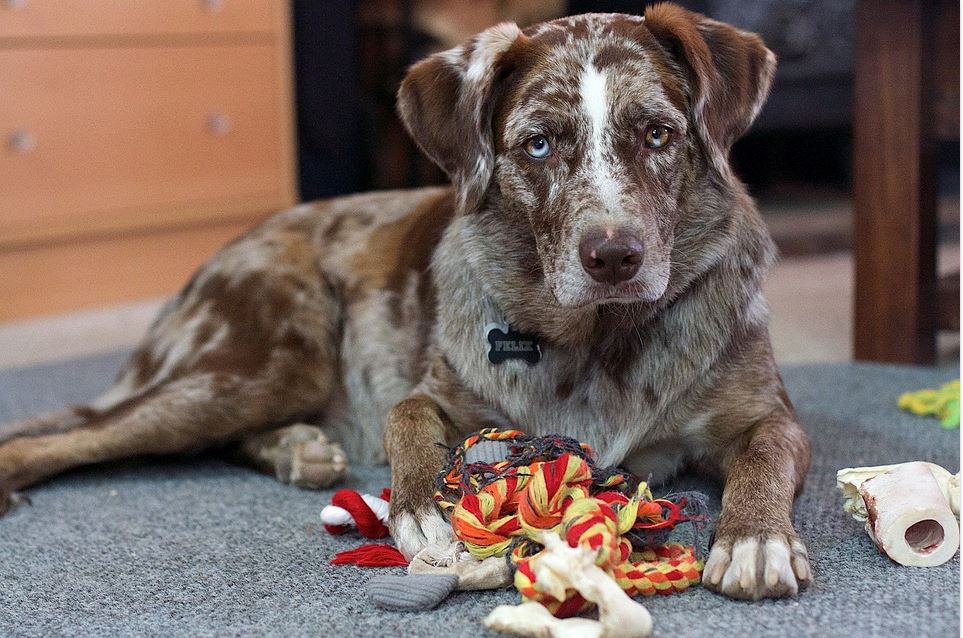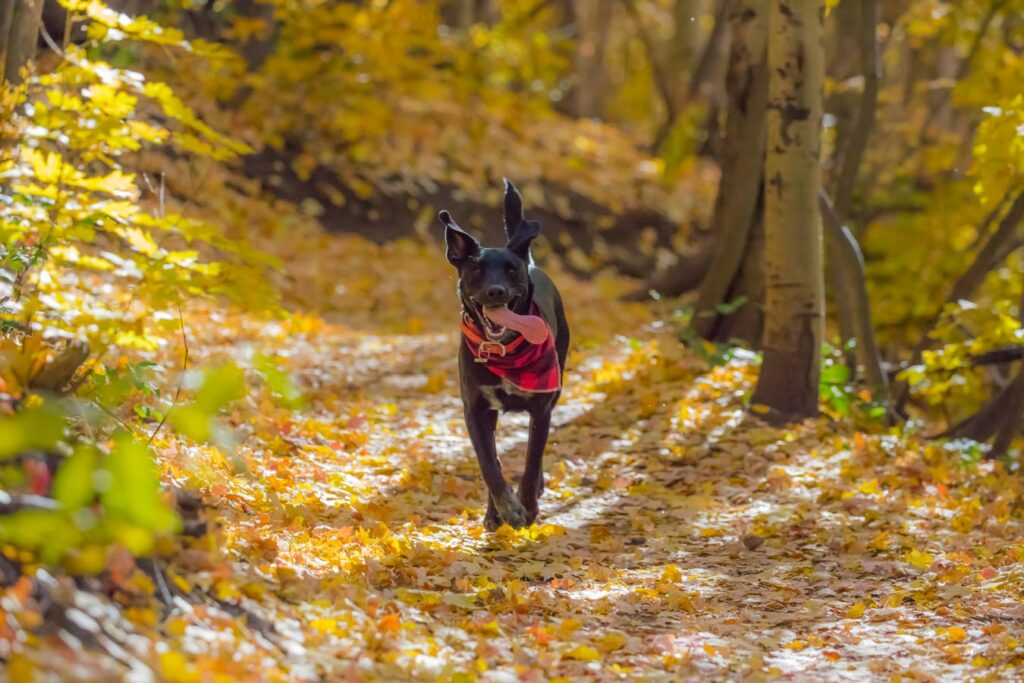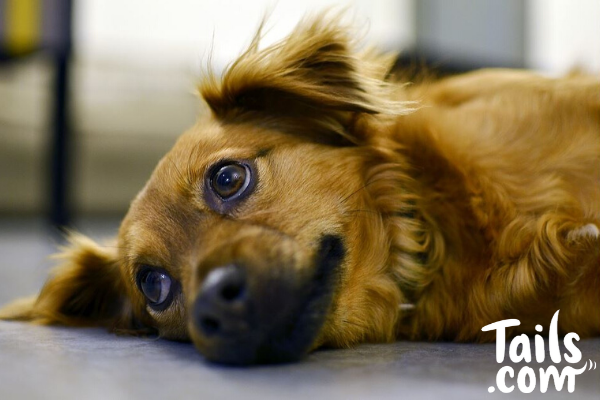When it comes to dogs, we think of waggy tails and those happy dog smiles. So when your dog shows signs of anxiety and anxious behaviours, it can feel very worrying.
Warning signs aren’t always obvious, so we’ve put together this blog on what causes anxiety in your dog, how to spot it, as well as sharing some helpful ways to help your dog feel calm.
Why is my dog anxious?
The first 16-18 weeks of a puppy’s life is their socialisation window. This is a crucial time for them to explore the world. As part of this, you should give your puppy space to interact with other dogs (a mix of breeds and sizes is great) and to introduce them to new situations, objects and people.
A properly socialised dog shouldn’t find new things terrifying. Exposing your dog to different experiences allows them to develop confidence and good social skills when interacting with other dogs. It can also help to prevent the development of anxieties in later life.

Causes of anxiety in dogs
Dog anxiety is usually caused by triggers in their environment. It stems from fear of the unknown, so if your dog wasn’t well socialised as a young puppy, they can develop stress and anxiety around new encounters – like people, animals, new places and even objects around the home.
Noise is another common cause of anxiety – especially in fireworks season. These loud noises and unfamiliar sounds overwhelm our dogs’ senses and they quickly become stressed, and in some cases, frantic.
Separation anxiety is another common form of dog anxiety, and is estimated to affect between 13 to 18% of dogs. It usually happens when a dog is left home alone – they find it hard to relax or get comfortable when they’re away from people they love. This can lead to destruction, excessive barking and other unwanted behaviours.
Sometimes separation anxiety can be confused with boredom, so it’s important to understand the true cause of your dog’s behaviour when you’re away from them. If their behaviour is due to a lack of mental stimulation, try out boredom busters such as chew toys and lick mats.

How to spot anxiety in dogs
Our dogs rely on body language and behaviour to communicate with us, so keep an eye out for some of the more common behaviours a stressed or anxious dog might display.
- Ears back
- Restless or at high alert
- Destructive behaviour
- Loss of appetite
- Shaking, cowering or hiding
- Panting
- Growling or baring teeth
- Biting or snapping
- Barking or howling
- Unwillingness to interact
If these behaviours are frequent and ongoing, it’s important to speak to a vet or behaviourist to help you identify the source of your dog’s anxiety.

How to treat anxiety in dogs
Speaking to your vet is the first step. They can help you identify the type of anxiety your dog has – as well as the possible triggers. Your vet will also be able to rule out any potential medical conditions that could be causing your dog’s behaviour.
Your vet may suggest behavioural therapy to manage your dog’s anxiety through training. A certified behaviourist will usually introduce desensitisation or counter conditioning methods. This is where you work on gradually changing your dog’s response to the trigger.
Behaviourists usually suggest you slowly expose your dog to their trigger in small doses whilst rewarding positive behaviour with treats and praise. Your dog will soon realise there is nothing to fear – only good things happen when they’re around the trigger. It’s important to remember that like with any training, patience and perseverance is key.
Exercise is as much a mood-booster for dogs as it is for humans. Burning off your dog’s energy reduces the likelihood that they’ll become wound up or hypersensitive to their surroundings. With highly anxious dogs, you can try exercising them in places or at times when they’re unlikely to encounter their triggers.
If your dog is extremely anxious, your vet might suggest that you try medication. It can help to relieve some of the symptoms and make your dog feel more relaxed – we recommend having a chat to your vet if you think your dog might need medication.

Common dog mental health issues
Depression: dogs experience depression in a similar way to humans. Your might might seem withdrawn and sad.
Canine Compulsive Disorder: when dogs get anxious, stressed or frustrated, they can develop compulsive behaviours to help them cope, such as spinning, barking, air snapping and more. They usually occur frequently throughout the day and for long periods of time.
Social anxiety: when dogs aren’t socialised as a puppy, being around other dogs and people can be scary – and lead to aggressive behaviours. Socialisation when dogs are young is important to make sure they feel comfortable in new situations when they’re older.
Separation anxiety: it’s a common condition that’s stressful for both dogs and owners. The anxiety can start as soon as you put your coat on or grab your keys, so working out the triggers will help you and your dog feel comfortable when it’s time to leave.
Why is my dog whining for no reason?
Dogs might whine for any number of reasons – excitement, frustration, attention seeking, pain, or simply because they want something. It can be a learned behaviour to get what they want or it might be because something else is going on.
Whining out of the blue for no reason could mean your dog is feeling worried, lonely or unhappy about their current situation. If your dog starts whining just before you leave the house, or starts panting and pacing, separation anxiety might be the cause.
If you think your dog is suffering from a form of dog anxiety, book an appointment with your vet. Anxiety and mental health disorders are tough for dogs and their owners, but by seeking help you’ll be well on your way to seeing your dog happy and relaxed again.


We have a 3yr cavapoo who has always been highly strung and nervous. She was well socialised from 9 weeks of age with our grandchildren and other visitors, plus puppy training class where she interacted with various breeds of dogs. However, after a number of weeks we stopped taking her to the puppy training classes with the advice of our vets, due to her starting with extreme saliving. As we first brought her home in the month of October, it was not long before she started hearing the sound of fireworks.
I say all this because what you have said above regarding socialising and not hearing loud noises when very young is not true of our dog at all.
Apart from the anxiousness in her, she is a very happy friendly dog who loves every-one
Myself and my two daughters have a Sprocker Ivy, which we rescued when she was 1.5 years old. The only information we have is that her owners were elderly and one of them was very ill so the dog had to go. She had totally shut down in the shelter and sat cowering in the corner and would eat or look at anyone from she had arrived 2 weeks previously. My daughter spent a long time in the pen with her to just try to gain her confidence and eventually the eyes started to brighten up. We went back the next day and her eyes lit up and when she was put on the lead she went for a short walk and she was like a new dog. We decided then to regime her and did all the necessary paperwork etc. When she was going home she ran and jumped into the car her eyes just lit up and wagged her tail and when she arrived home she ran about the house like a mad thing totally enjoying herself. But when visitors would call she turned into a different dog and cowered away and actually lost control of her bodily functions especially if a man arrived and the older the man the worse she was and also petrified of vans. We do not know what has happened in her young days but she is now almost 4 and these phobias are still there. Maybe just as not as intense but still very much there today and very protective of us all especially my daughter that she first bonded with. I did have a guy to assess her to see what her issues were and he seemed to think as a puppy that she had not been socialised and probably kept confined and shouted at by a man as she was no doubt very boisterous as a puppy. He did not feel she had been physically abused as such and it would just take time for her to come round. The vet said something similar so we try to do what we can. I’m just wondering if anyone can give any more tips to help her overcome her fears.
You any suggestions to how to stop laci and pebbles barking at dogs and animals on the tv they get high as a kite and when out there the same towards other dogs it’s a shame
Hi Carol,
The best thing to do if you’re struggling to stop them from barking at other animals/dogs (on the TV and outside) would be to either have a chat with your vet, or speak to a behaviourist who should be able to help!
Millie
Hi, I have 2 11 week old puppies who are generally very sociable. One has started growling intermittently when being handled – it is usually when she is sleeping. We have tried giving her warnings i.e stroking her before we move her, this does not seem to help.
Could you give some advise on how to handle this behaviour.
I am aware there are issues having sibling dogs and we are trying to mitigate the potential issue (they eat separately, sleep separately and I have started training them separately) could this be contributing to her new behaviour.
Many thanks
Hi Emma,
It would be best to have a chat with your vet or a behaviourist to get to the bottom of this – they’ll be the best to help you understand.
Millie
I have my daughter’s dog, she moved to another state. Before she was this daughter’s dog, she belonged to my oldest daughter who passed away. Piper is a 4 yr old Shitz Tsu/Bischon mix. She is a loving cuddly dog,but was raised with 2 large breeds and was territorial aggressive with treats and bones, she still is so we just don’t have bones for oyr dogs.( I have 2 more dogs of the same mix breed) Piper has also shown agression when my husband moved her in the bed, it was dark, she growled and snapped and bit him. She did it again when he tried to move her on the couch and tried pushing her butt over to scoot her out of the way, this time she drew blood on him when she snapped and but him. Help..I’m desperate, I don’t want to rehome her, she’s my connection to my late daughter..but I also have grandkids that I don’t want bitten either. I need advice and guidance..thank you
Hi Alisa – I’m sorry to hear about your daughter. It sounds like Piper has been through a lot, so she’s probably quite anxious and confused by all the changes happening. I would recommend having a chat to your vet or to an accredited behaviourist who will be able to help work out what’s causing the behaviour, and work with you on some training mechanisms to help you both, and particularly to help Piper settle in to her new environment. Good luck 🙂
Hi I’ve got 11 and half month old german shephard who wasn’t socialised much due to her being not well when she was a puppy its got to the stage she barks and goes after some folk when out for walks and is scared of other dogs she seems to have a lot of anxiety is there anything I can do
I have an 8 month old English bull terrier. He is very sociable and was never left in his own until he was about 4 months old and only then for small amounts of time building up to about 3/4 hours now. Over the last month he has started biting his flank – usually when he is tired and also has a small 5 lens’s size bald patch appear on his head between his ears. He had always tail spun and bites his tail (quite chin in bullies) but these all seem to be becoming habits which are getting worse. Any suggestions as to what I should or can do to help him especially the flank biting as I am worried he will start to make it sore.
Alison
3 February 2022
Our 3 year old wire haired fox terrier is very anxious when walking along the road when passed by large lorries or tractors. She will shake and pull away as far as she can. Also she will not use the dog flap because of the clattering when it closes so she will have accidents in the house. However if we prop the flap open she will use it without any problem. What do we do to help her and us with this situation?